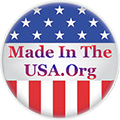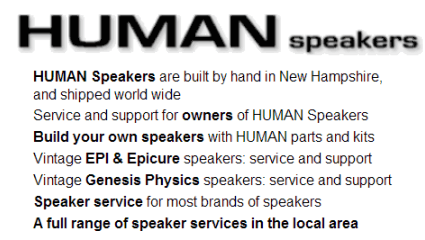One of the products Human Speakers sells is Made in America Bass Speakers. A more complete list of their products is provided by Made in America Secrets, to review their list click here.
For more information about Human Speakers and its American Made products see the following:
EPI was founded in 1970 by Winslow Burhoe, to manufacture speakers based on the module he had designed. This module consisted of an eight inch woofer and a one inch tweeter. Many different speakers were built using various combinations of this module, and a six inch version of the woofer. They were wonderful speakers and are still usually prized by their owners, who will frequently go to great lengths to repair them properly when they (rarely) develop problems.
As time went by market forces demanded new and improved product lines and more a modern look to the product (and the promotional literature...) and so what I call the intermediate line was rolled out. Some of these speakers were essentially the same as previous models, but they all had an updated look. These speakers carried an A prefix to their model numbers, all that is except the venerable 100, which had the new look but not the new name. The A300 and A500 were introduced, and were actually quite different from previous EPI speakers.
By the late seventies the market was requesting its usual superficial changes in order to have something to talk about, and so the EPI line was overhauled again, more radically, to create the Time/Energy speakers. The new woofers were similar to the older ones, except the cones were a very interesting laminate. A clear Lexan body was glued to the foam from the surround which extended behind it almost to the apex where the voice coil attaches. The tweeters used with these woofers were polycarbonate dome tweeters which sounded pretty good, but if driven hard sometimes actually melted a circle in the dome where the voice coil would heat up.
In the eighties the Magnus line was produced with 10 and 12 woofers and several different various cone and horn midranges and tweeters. Marketed to a different segment of buyers than the previous lines, these speakers have a fairly impressive sound, given the growing cost limitations of the market and the imaging drawbacks to using larger diameter woofers in general.
There were also a couple of other series of speakers produced - the Epicure 1 through 5, which were pretty interesting speakers, though they to bear little resemblance to the older speakers, and the EPI model 1.0, 2.0, and 3.0. These were quite impressive speakers, enjoying a lot of the strengths of the traditional EPI/epicure engineering while incorporating a number of subtle improvements in their design, most notable the truncated pyramid of the 3.0 cabinet, with the tweeter mounted in free space on the top.
I have managed to give a few speakers short shrift here, maybe I will write more in the future about the Stat 450, the microtowers, and the car speakers. For now this will have to do.
As the years went by, even though the speakers were still good, there was a more corporate look and feel to the product lines. This culminated in the early nineties when home entertainment giant Harman International bought the trademark and the remaining inventory, tucking them into an office next to JBL in Woodbridge, NY. Harman built several inexpensive speakers with the EPI label, which I believe have been discontinued at this point.
I specialize in building parts for the older speakers. I have many, many of the parts required to repair the later lines. I can answer a lot of questions and help you (I hope) with problems or mysteries relating to most of the models - feel free to contact me.
For more information about Human Speakers and its American Made products see the following:
EPI was founded in 1970 by Winslow Burhoe, to manufacture speakers based on the module he had designed. This module consisted of an eight inch woofer and a one inch tweeter. Many different speakers were built using various combinations of this module, and a six inch version of the woofer. They were wonderful speakers and are still usually prized by their owners, who will frequently go to great lengths to repair them properly when they (rarely) develop problems.
As time went by market forces demanded new and improved product lines and more a modern look to the product (and the promotional literature...) and so what I call the intermediate line was rolled out. Some of these speakers were essentially the same as previous models, but they all had an updated look. These speakers carried an A prefix to their model numbers, all that is except the venerable 100, which had the new look but not the new name. The A300 and A500 were introduced, and were actually quite different from previous EPI speakers.
By the late seventies the market was requesting its usual superficial changes in order to have something to talk about, and so the EPI line was overhauled again, more radically, to create the Time/Energy speakers. The new woofers were similar to the older ones, except the cones were a very interesting laminate. A clear Lexan body was glued to the foam from the surround which extended behind it almost to the apex where the voice coil attaches. The tweeters used with these woofers were polycarbonate dome tweeters which sounded pretty good, but if driven hard sometimes actually melted a circle in the dome where the voice coil would heat up.
In the eighties the Magnus line was produced with 10 and 12 woofers and several different various cone and horn midranges and tweeters. Marketed to a different segment of buyers than the previous lines, these speakers have a fairly impressive sound, given the growing cost limitations of the market and the imaging drawbacks to using larger diameter woofers in general.
There were also a couple of other series of speakers produced - the Epicure 1 through 5, which were pretty interesting speakers, though they to bear little resemblance to the older speakers, and the EPI model 1.0, 2.0, and 3.0. These were quite impressive speakers, enjoying a lot of the strengths of the traditional EPI/epicure engineering while incorporating a number of subtle improvements in their design, most notable the truncated pyramid of the 3.0 cabinet, with the tweeter mounted in free space on the top.
I have managed to give a few speakers short shrift here, maybe I will write more in the future about the Stat 450, the microtowers, and the car speakers. For now this will have to do.
As the years went by, even though the speakers were still good, there was a more corporate look and feel to the product lines. This culminated in the early nineties when home entertainment giant Harman International bought the trademark and the remaining inventory, tucking them into an office next to JBL in Woodbridge, NY. Harman built several inexpensive speakers with the EPI label, which I believe have been discontinued at this point.
I specialize in building parts for the older speakers. I have many, many of the parts required to repair the later lines. I can answer a lot of questions and help you (I hope) with problems or mysteries relating to most of the models - feel free to contact me.

